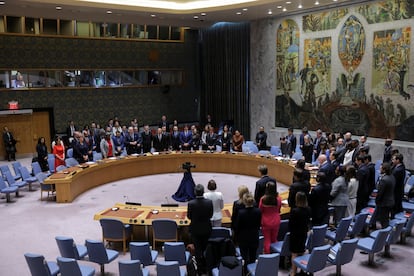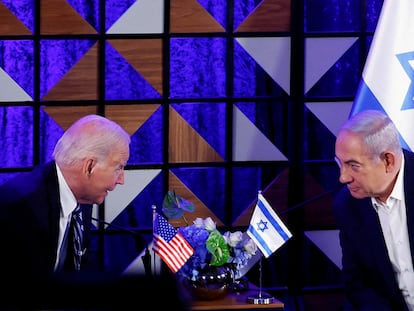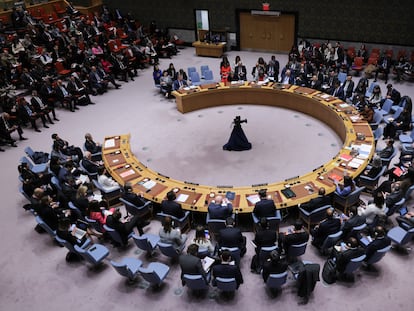US sparks controversy at the UN with claim that Gaza ceasefire resolution is ‘non-binding’
The majority of members of the Security Council and numerous experts reject this reading and believe that the text is binding, even if the organization does not have the coercive power to make sure Israel and Hamas adhere to it


By abstaining in the vote on the U.N. Security Council resolution demanding an immediate ceasefire in Gaza, the United States on Monday sparked not only the anger of Israel, which had asked it to veto the text, but also a sweeping legal and diplomatic controversy due to its claims that the resolution — the first to be passed since the start of the Gaza war — was “non-binding.” For Washington, it was a rhetorical feint aimed at making the public blow to its great ally in the Middle East less obvious. A non-binding resolution does not force Israel to do anything in principle, much less agree to end hostilities, a call the country has rejected since the start of the war in October.
“A non-binding resolution.” That’s how both Linda Thomas-Greenfield, the U.S. ambassador to the U.N., and John Kirby, White House National Security Communications Advisor, described U.N. Security Council Resolution 2728. “There’s no impact at all on Israel,” added Kirby. These claims hit the U.N. Security Council — the highest executive body of the U.N., in charge of ensuring world peace and security — like a torpedo. Were the Council’s resolutions binding or not? Or was it that some resolutions were binding and others were not?
Diplomatic representatives and legal experts came out in force to refute Washington’s claim. U.N. Secretary-General António Guterres made his opinion clear: the resolutions are binding. Indeed, this is stated in Article 25 of the U.N. Charter: “The Members of the United Nations agree to accept and carry out the decisions of the Security Council in accordance with the present Charter.”
Several representatives of the Security Council, led by Mozambique and Sierra Leone, pointed to case law to support this argument. The two African diplomats, both with legal training, said that the Gaza ceasefire resolution is binding, regardless of whether one of the five permanent members of the Council abstains from the vote, as was the case of the U.S. The diplomats highlighted that in 1971, the advisory opinion of the International Court of Justice (ICJ) established that all resolutions of the U.N. Security Council are legally binding. The Algerian ambassador to the U.N. summed it up even more categorically: “Security Council resolutions are binding. Not almost, not partly, not maybe.”
Legal unanimity
The United States waded into muddy waters on Monday, not only against Israel but also before the sole arbiter of the international community with its strident interpretation of the resolution, and it nearly completely diverted attention from the fact that the Council had successfully — if belatedly — passed the first resolution on the Gaza war.
Adil Haque, professor of International Law at Rutgers and executive editor of Just Security, has no doubts that the resolution is binding. “According to the U.N. Charter, all decisions of the Security Council are binding for all member states. The International Court of Justice has ruled that a resolution need not mention Chapter VII of the Charter [action in case of threats to the peace, breaches of the peace or acts of aggression], refer to international peace and security or use the word ‘decides’ to make it binding. Any resolution that uses ‘mandatory language’ creates obligations, and this includes the term ‘demands’ used in the resolution on Gaza,” explains Haque, who also stresses the “decisive intent” of the Council members who drafted and voted in favor of the ceasefire resolution; only the South Korean representative was hesitant at first. “They intended it to have a binding effect.”
On what grounds does Washington argue that the resolution is “non-binding?” Is it more of a political calculation than a legal objection? “For now, it does not seem that the U.S. has a coherent legal argument,” explains Haque. “Initially, it alleged that the resolution did not use adequate language to have a binding effect. The ICJ has ruled that resolutions do not need to use any particular ‘magic word’ and that a mandatory term such as ‘demands’ is enough to create obligations. The U.S. later argued that the resolution did not create any new obligations. But the resolution demands ‘an immediate ceasefire during the month of Ramadan,’ which is a new obligation.” Haque warns that Washington’s current objection could be used as a precedent in other resolutions: “Its stance [on Resolution 2728] may undermine other important resolutions that the country itself championed, including the recent one calling for a ceasefire in Sudan.”
Richard Gowan, who was a senior official at the U.N. for decades and today works at the NGO International Crisis Group, specialized in conflict prevention, believes that the controversy is due to a substantial difference in interpretations. “Different states interpret the Charter in different ways and follow different traditions of interpretation. There are genuine and important differences in the way the U.S. and other Council members read this text. American jurists will believe that the fact that the text ‘demands’ a ceasefire means that it is not legally binding,” explains the expert, in line with what Haque stated. “From the American point of view, the text would have to have ‘decided’ on a ceasefire to be legally binding.” Demand or decide: the intricate language of diplomacy. “It may seem like a very small distinction,” explains Gowan, “but it has its origins in Article 25 of the U.N. Charter, which says that states must ‘accept and carry out the decisions’ of the Council, but it doesn’t mention its demands.”
“Important diplomatic sign, but with little force”
Gowan argues that the confusion over whether the resolution was binding could have been what allowed it to pass on Monday. “The different interpretations of the text (which the ambassadors and their legal teams were surely aware of) allowed the United States to abstain from a resolution that it considers non-binding, and this could have been advantageous, because if it had seen it as legally binding it could have felt obliged to veto it,” he explains. Conversely, says Gowan, “other members of the Council might have been dissatisfied with a text that they considered simply rhetorical.”
For Gowan, the result of Monday’s vote was a satisfactory final compromise — the passage of the first resolution since the start of the Gaza war — that was made possible due to the ambiguity over a couple of terms. But he points out a potentially negative side: “Of course, it may be a source of confusion if Israel declares that it does not feel bound by the text… That could lead to more discussions in the Council shortly. The happy feelings of today [Monday] in New York could soon evaporate.”
The U.S. ambassador to the U.N. on Monday argued that the resolution was non-binding as it did not fall under the remit of Chapter VII, which would authorize the use of force to implement it. Gowan points out how difficult its application is, regardless of the chosen mode. “It is clear that the resolution does not contain any enforcement mechanism of its own, and if other Council members proposed sanctions against Israel for non-compliance, the U.S. would veto them. So ultimately the resolution is an important diplomatic sign about the need for a ceasefire, but it has little force.”
Many observers within and outside of the U.N. believe that the prolonged negotiation (lasting almost a month) of the ceasefire draft resolution linked to the release of the hostages presented by the United States, and vetoed last Friday by Russia and China, was nothing more than a diplomatic maneuver aimed at gaining time (or rather losing it) while Washington staked it all on the Israel-Hamas negotiations that it is mediating alongside Egypt and Qatar. (And while Israel, against Washington’s wishes, perseveres with its ground offensive plans in Rafah). In other words, to let the U.N. take action, but not too much — for that, it has its veto, which it has used to reject three previous ceasefire resolutions — while the real game is being played out.
Gowan’s idea that the resolution is an important diplomatic message, but one that lacks force, suggests it is all just a battle of words, where the difference between “demand” and “decide” would escape even a linguist. Meanwhile, the real battle continues in Gaza, where more than 32,000 people have been killed in Israel’s attacks.
Sign up for our weekly newsletter to get more English-language news coverage from EL PAÍS USA Edition
Tu suscripción se está usando en otro dispositivo
¿Quieres añadir otro usuario a tu suscripción?
Si continúas leyendo en este dispositivo, no se podrá leer en el otro.
FlechaTu suscripción se está usando en otro dispositivo y solo puedes acceder a EL PAÍS desde un dispositivo a la vez.
Si quieres compartir tu cuenta, cambia tu suscripción a la modalidad Premium, así podrás añadir otro usuario. Cada uno accederá con su propia cuenta de email, lo que os permitirá personalizar vuestra experiencia en EL PAÍS.
¿Tienes una suscripción de empresa? Accede aquí para contratar más cuentas.
En el caso de no saber quién está usando tu cuenta, te recomendamos cambiar tu contraseña aquí.
Si decides continuar compartiendo tu cuenta, este mensaje se mostrará en tu dispositivo y en el de la otra persona que está usando tu cuenta de forma indefinida, afectando a tu experiencia de lectura. Puedes consultar aquí los términos y condiciones de la suscripción digital.
More information
Archived In
Últimas noticias
Most viewed
- Oona Chaplin: ‘I told James Cameron that I was living in a treehouse and starting a permaculture project with a friend’
- Reinhard Genzel, Nobel laureate in physics: ‘One-minute videos will never give you the truth’
- Sinaloa Cartel war is taking its toll on Los Chapitos
- Why the price of coffee has skyrocketed: from Brazilian plantations to specialty coffee houses
- Silver prices are going crazy: This is what’s fueling the rally










































